

India 1988-89
Page 1
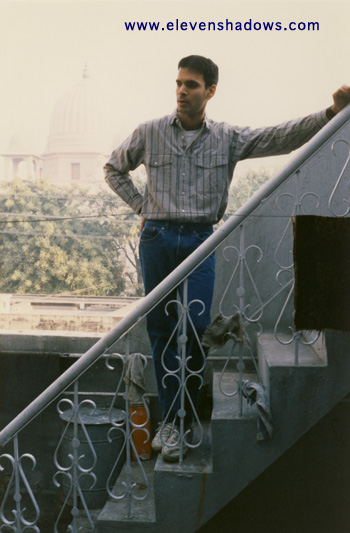 Tom
on top of his uncle Papu's apartment roof, with the Ramakrishna Temple in
the background in a rare photo of Tom perfectly healthy in India. Papu owned
a furniture shop in New Delhi, and his apartment was only several doors down
from the shop. Tom
on top of his uncle Papu's apartment roof, with the Ramakrishna Temple in
the background in a rare photo of Tom perfectly healthy in India. Papu owned
a furniture shop in New Delhi, and his apartment was only several doors down
from the shop.I'm creating these web pages almost twenty years after going on the trip. And perhaps as a result of this, it may have a slightly different feel. I think it seems more like a personal photo album. And too, the comments I have are almost twenty year old memories. One of the things that sticks out in my mind was getting to Papu's late at night. As we drank tea after arriving from the airport, I heard a couple of dogs barking nearby. I asked, "Are those your dogs?" Papu, Vena (his wife), and everyone else who lived there immediately erupted into gales of laughter. Almost in tears, Papu gasped between laughs, "I'm sorry, but you don't know how funny that is...you see, in America, you have dogs as pets. But here, we don't have dogs anymore than we can say that we have these houseflies!" I knew then that I was in a very different country. Nowadays in India, it's more common to have housepets. |
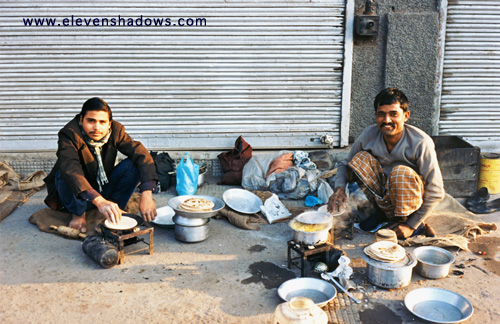 I
saw these friendly people every morning when I walked down the stairs from
Papu's onto the street. They lived in the entrance to Papu's
apartment. Every morning they would fry chapatis (flat bread) and dal for
breakfast. Papu said that they knew them well, and that they had been
living there for years. I remember thinking, "Would I ever let people
live by my front door?" I
saw these friendly people every morning when I walked down the stairs from
Papu's onto the street. They lived in the entrance to Papu's
apartment. Every morning they would fry chapatis (flat bread) and dal for
breakfast. Papu said that they knew them well, and that they had been
living there for years. I remember thinking, "Would I ever let people
live by my front door?"
Papu and Tom referred to them as baiyas. English speakers in India frequently call them "pavement dwellers". When I was creating this page, I hesitated in putting this photo here, as many in the West still associate India with crushing poverty. While "pavement dwellers" are a large problem in urban India, even twenty years later, India has made enormous strides in bringing up its crushing poor into the middle class. I've been to India five times, and each time I go, I see large gains in the middle class and huge improvements in their infrastructure, financial strength, and the way they treat those in need. |
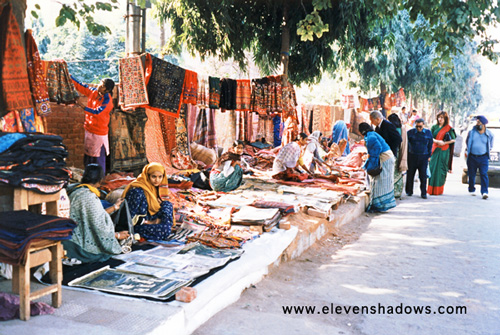 This
is one of the many street markets off Janpath Road in New Delhi, near
Connaught Place. This
is one of the many street markets off Janpath Road in New Delhi, near
Connaught Place. |
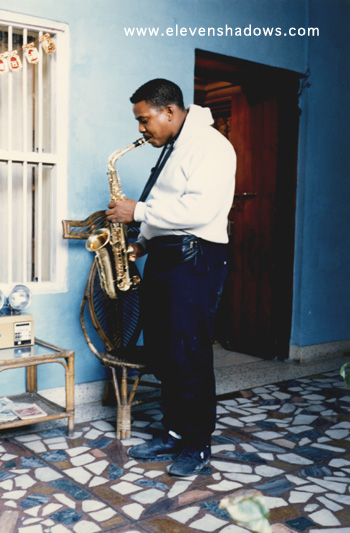 Oran
practicing saxophone at Papu's apartment. Oran, son of
Alice
and John Coltrane, traveled with Tom and I for a month before traveling to
South India for one more month to learn with Sai Baba. Oran now plays
guitar and sings with his band
Oranyan. Oran
practicing saxophone at Papu's apartment. Oran, son of
Alice
and John Coltrane, traveled with Tom and I for a month before traveling to
South India for one more month to learn with Sai Baba. Oran now plays
guitar and sings with his band
Oranyan. |
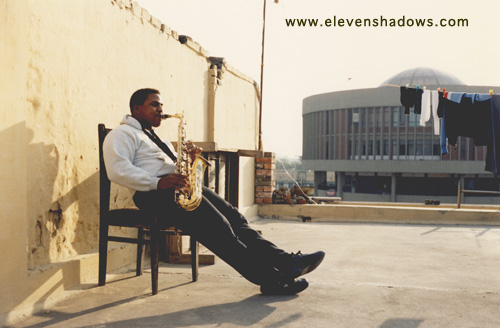 Oran
practicing saxophone as the son sets on Papu's roof. Oran
practicing saxophone as the son sets on Papu's roof. |
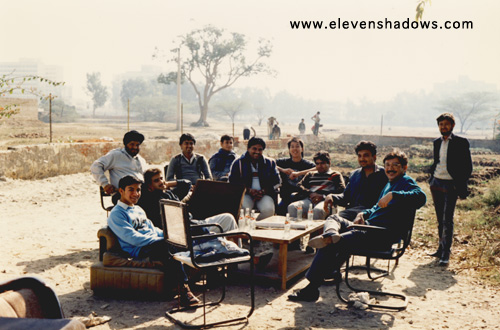 Posing
with some friends and family of Papu, New Delhi. Posing
with some friends and family of Papu, New Delhi. |
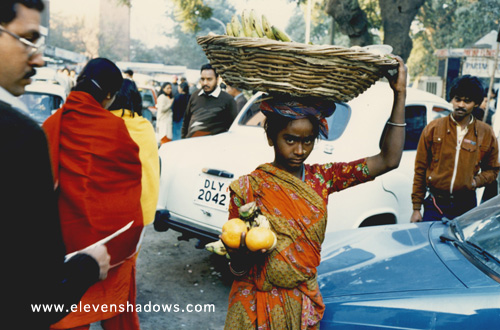 Selling
fruit by Janpath Road, New Delhi. Selling
fruit by Janpath Road, New Delhi. |
 "There is one God; mankind is one; the foundations of
religion are one."
"There is one God; mankind is one; the foundations of
religion are one."We visited the Baha'i Lotus Temple (Bahai Mandir) in New Delhi, my first introduction to their faith. The Baha'i faith believes that the world's religions are a continually evolving process in through God's messengers, or Manifestations of God. These include Adam, Noah, Zoroaster, Krishna, Abraham, Moses, Buddha, Jesus and Muhammad, with Baha'ullah from Persia being the most recent, but not the last, of these great teachers. A chief mission of Baha'ullah was to establish unity between the world's religions. The interior of the beautiful lotus temple was filled with quotes from Baha'ullah, and someone from the temple further explained the quotes and told us about the religion. |
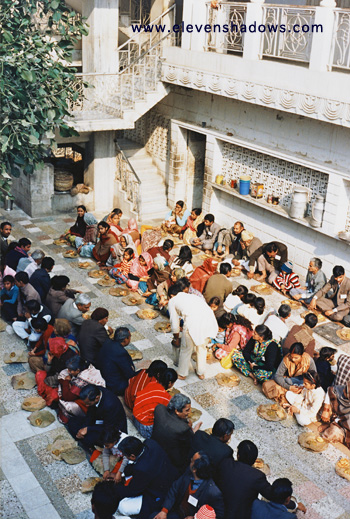 After
visiting the Lotus Temple, we also went to a Hindu Temple. I don't
remember the name of this temple, but it is located rather close to the
Lotus Temple. After
visiting the Lotus Temple, we also went to a Hindu Temple. I don't
remember the name of this temple, but it is located rather close to the
Lotus Temple. |
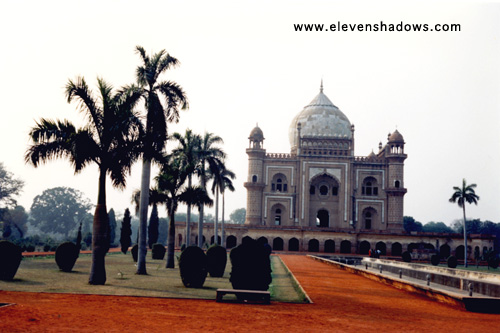 Safdarjung's
Tomb, New Delhi. Safdarjung's
Tomb, New Delhi.Built of red sandstone and buff stone, this tomb is built for Safdarjung, the powerful prime minister of Muhammad Shah who was the weak Mughal emperor from 1719 to 1748, and is an example of late Mughal architecture. |
 Safdarjung's
Tomb, New Delhi, with Tom, me, and Mitu, a relative of Tom who also lives in
New Delhi. Safdarjung's
Tomb, New Delhi, with Tom, me, and Mitu, a relative of Tom who also lives in
New Delhi. |
 Papu
and his family took us by car to Agra, where the Taj Mahal is located.
We stopped off at a roadside restaurant. Papu
and his family took us by car to Agra, where the Taj Mahal is located.
We stopped off at a roadside restaurant.
I remember being transfixed with how such disparate modes of transportation - burros with overloaded trailers, Ambassador cars, and lumbering trucks - shared the road. |
 Papu,
his wife Vena, and Smriti at the Agra fort, across the river from the Taj
Majal. Papu,
his wife Vena, and Smriti at the Agra fort, across the river from the Taj
Majal. |
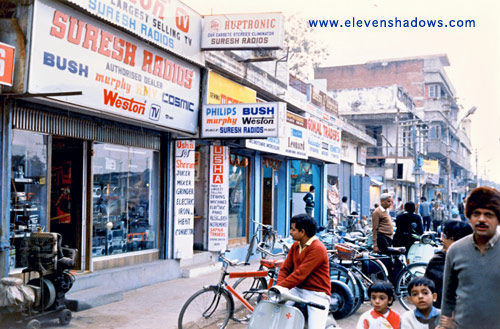 The
streets of Agra. We had a friend named Suresh who lived in Los
Angeles, and were compelled to photograph this store. I don't know if
Suresh ever saw this photo. The
streets of Agra. We had a friend named Suresh who lived in Los
Angeles, and were compelled to photograph this store. I don't know if
Suresh ever saw this photo. |
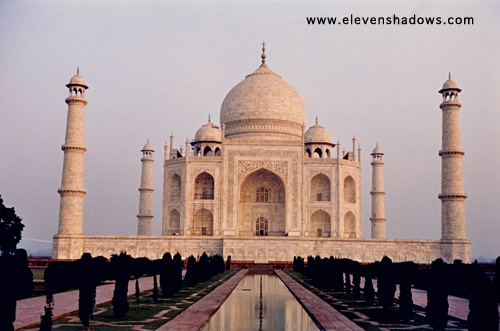 Early
morning at the Taj Majal. Early
morning at the Taj Majal.Emperor Shah Jahan had it built as an eternal resting place for his favorite wife, Mumtaz Mahal. Construction began in 1632 and was completed in approximately 1648, using 20,000 artisans. The Taj Mahal is arguably the finest example of Mughal architecture, a style that combines elements of Persian, Turkish, Indian, and Islamic architectural styles. The Taj Mahal became a UNESCO World Heritage Site in 1983 when it was described as a "universally admired masterpiece of the world's heritage." Papu was noticeably proud of showing us the Taj Mahal. We heaped praise upon it, as it is truly an amazing work of art. I did make a comment that I instantly regretted, saying that it was actually a bit smaller than I thought it would be, causing Papu some consternation for a moment. More photos of the Taj Mahal closer up on the next page... |
India 1988-1989
Page 1